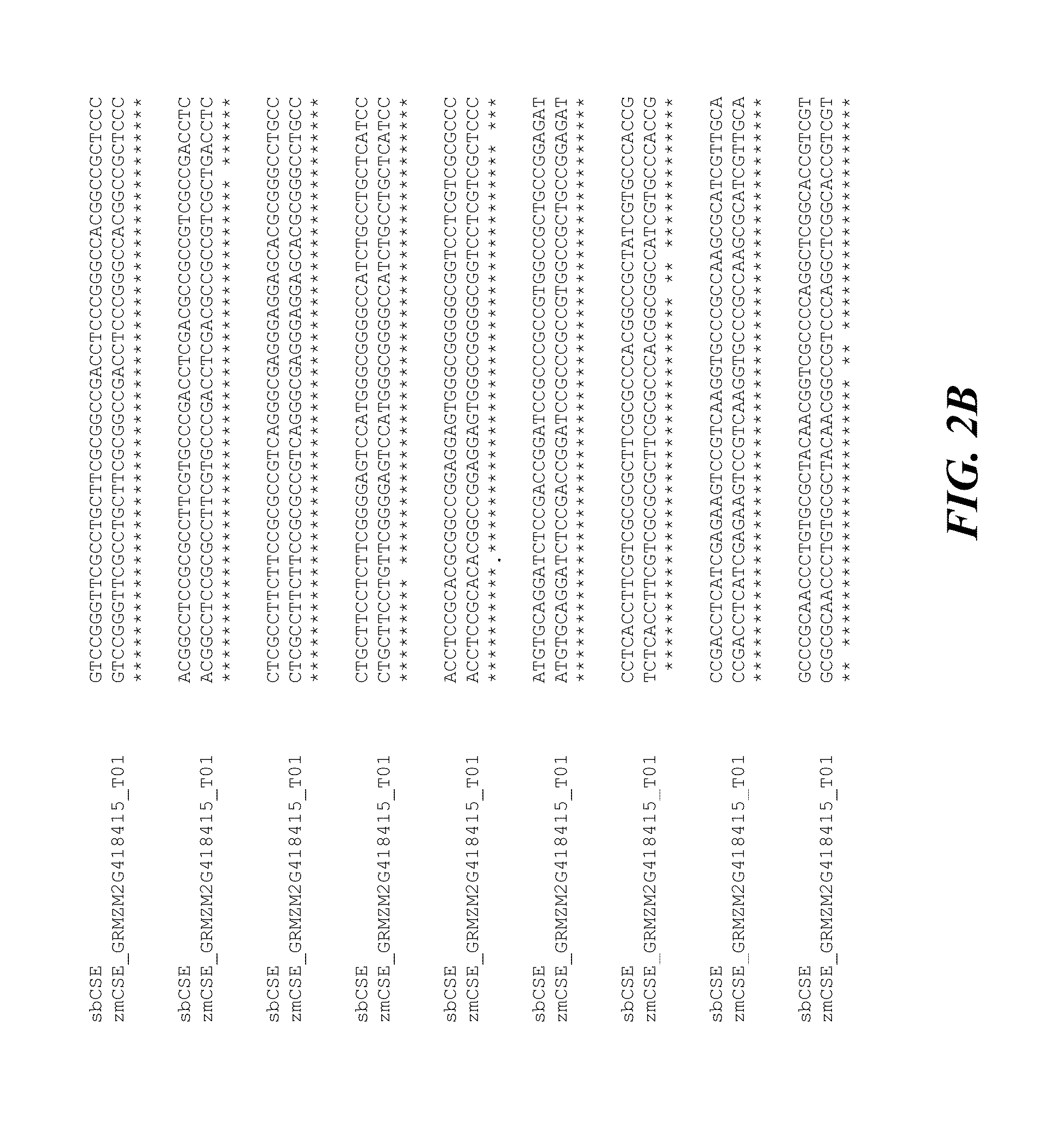Compositions for reduced lignin content in sorghum and improving cell wall digestibility, and methods of making the same
a technology of lignin and composition, which is applied in the field of reducing lignin sorghum composition and the field of making the same in sorghum, can solve the problems of loss of target gene function, achieve the effects of reducing lignin biosynthesis, suppressing and/or silence of sbcse gene expression, and reducing lignin biosynthesis
- Summary
- Abstract
- Description
- Claims
- Application Information
AI Technical Summary
Benefits of technology
Problems solved by technology
Method used
Image
Examples
example 3
Analysis of Expression Profiles of SbCSE
[0134]To understand the expression pattern and localization of SbCSE, a gene expression microarray analysis was performed, examining expression in whole plants as well as specific tissues. We conducted a microarray analysis of putative SbCSE (SEQ ID NO:6) using a microarray dataset from different sorghum tissues that we had previously produced and compared SbCSE's expression to the gene expression pattern of the house-keeping gene SbActin. The results of the microarray analysis of gene expression (shown in Table 18) suggests that the SbCSE is constitutively expressed in various tissues, including both tissues that are rich in primary (seedling shoot, root and stem pith) and secondary cell walls (whole stem and in isolated rind tissues). Thus the constitutive expression of SbSCE in all tissues suggest the role of SbSCE in both primary cell wall and secondary cell wall biosynthesis in sorghum.
TABLE 18Microarray analysis results (all values are i...
example 4
Production of DNA Elements for RNAi Vectors
[0135]Three fragments from the SbCSE cDNA transcript are used in three different RNAi constructs. The three fragments are localized (1) in the 5′ portion of the coding region (SEQ ID NO:11), (2) the central portion of the open reading frame (SEQ ID NO:12), and (3) the 3′ portion of the open reading frame (SEQ ID NO:13), respectively as shown in Table 15 above. The RNAi cassette for target DNA sequences (including the necessary restriction enzyme sites at the ends of the synthesized DNA fragments) are synthesized and shown in Table 19 (SEQ ID NOs:14-19). Either the maize Ubiquitin promoter (ZmUbi) and Arabidopsis terminator (AtT6) or sorghum CSE promoter (upstream 2 kb) and Arabidopsis terminator (AtT6) or SbCSE terminator (Sb-CSE) are synthesized and cloned into the pUC57 vector. Each synthesized RNAi cassette is cloned into a promoter terminator vector backbone. The silencing constructs shown in Table 19 can produce hairpin RNA (hpRNA) of ...
example 5
Vector Construction
[0137]The RNAi vector is created in order to incorporate the desired DNA elements for the SbCSE RNAi experiment (FIG. 1). The antisense and sense DNA elements including the necessary restriction enzyme sites at the ends of the synthesized DNA fragments are synthesized and cloned into the multi cloning site of pUC57 (shown in Table 11). The maize Ubiquitin promoter (Zm-Ubi v3) and Arabidopsis terminator (At-T6 v1) or sorghum CSE promoter (upstream 2 kb) (Sb-CSE v1) and Arabidopsis terminator (At-T6 v1) are synthesized as shown in Table 12. The promoter and terminator element (P / T) cassettes start with Pacl and end with Pacl. Between the promoter and terminator are four restriction enzyme sites: Sacl, Ascl, Swal and Kpnl. High throughput vector system (HTPV) containing multiple cloning sites and a plant selective marker (for example, the Yatl promoter driving expression of the Nptll gene for Geneticin® (Life Technologies) resistance) are synthesized. The synthesized...
PUM
| Property | Measurement | Unit |
|---|---|---|
| Structure | aaaaa | aaaaa |
| Digestibility | aaaaa | aaaaa |
| Content | aaaaa | aaaaa |
Abstract
Description
Claims
Application Information
 Login to View More
Login to View More - R&D
- Intellectual Property
- Life Sciences
- Materials
- Tech Scout
- Unparalleled Data Quality
- Higher Quality Content
- 60% Fewer Hallucinations
Browse by: Latest US Patents, China's latest patents, Technical Efficacy Thesaurus, Application Domain, Technology Topic, Popular Technical Reports.
© 2025 PatSnap. All rights reserved.Legal|Privacy policy|Modern Slavery Act Transparency Statement|Sitemap|About US| Contact US: help@patsnap.com



